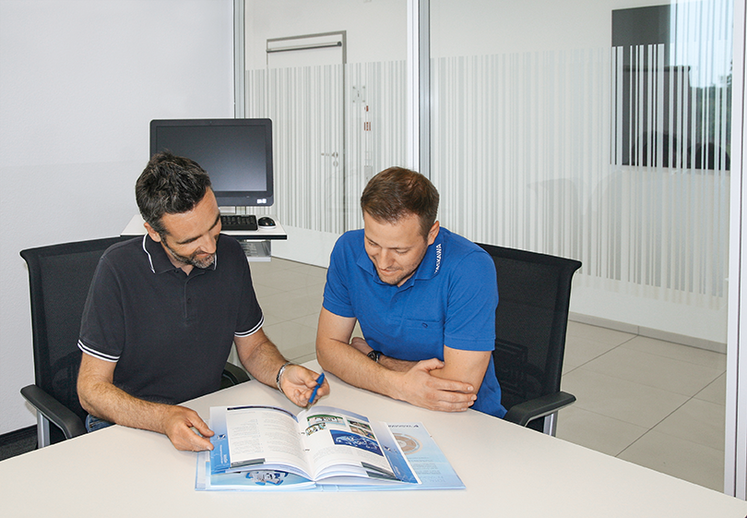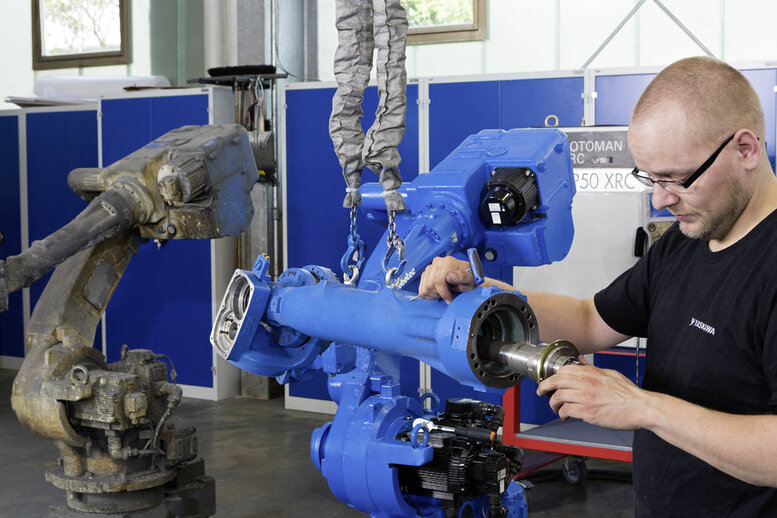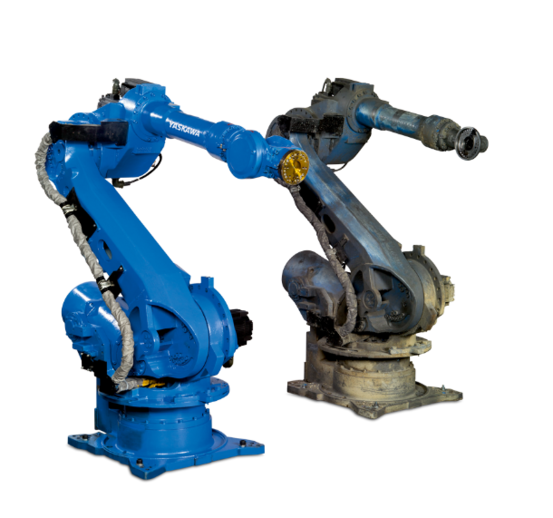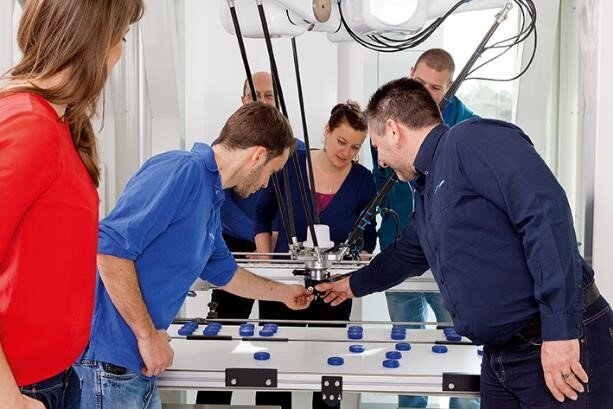Our industry-leading, high-speed industrial robots include high-payload, extended-reach, ultra-maneuverable seven-axis and unique 15-axis dual-arm robots.
Production restart after the winter break: recognizing – and avoiding – cold-related problems in industrial robots
Industrial robots need neither regular sleep nor a break. Not without reason are they indispensable in modern production facilities. Nevertheless, a planned production downtime is sometimes unavoidable – for example during the Christmas holidays. It is thus all the more important that the resumption of production after such a break should run smoothly.
Planned breaks are to be found in all production calendars. They may range in length from a few days to several weeks – and in each case things should go smoothly. After all, industrial robots perform key tasks at different points of the automated production.
The reality is often quite different: the plant is to be restarted, but the robot refuses to move, or a fault signal lights up. Typical problems in these cases are loss of alignment, failure to recognize an otherwise familiar program or an empty memory. Normally, the cause is easily found and would have been avoidable with low costs and minimum time expenditure. These unpleasant – and extremely costly – surprises are experienced more often than not by companies lacking properly trained staff.
Test of electrical components
Most robot controllers have one or more batteries. When the controller is switched off, whether deliberately or inadvertently, a “clean” shutdown and saving of all critical data – such as position, program or user data – is ensured. In the case of a winter shutdown with accompanying low temperatures and high humidity, the electrical components should be checked prior to the return to service: first of all the batteries, then the circuit boards and plug connectors that are susceptible to electrical short circuits due to high humidity. Luckily, humidity in the control cabinet can be easily prevented, e.g. by drying cushions with silica gel or similar air-drying methods.
Maintenance manuals provide instructions for handling and recommend replacing the controller batteries for preventive reasons after a certain number of operating hours or years, to ensure correct functioning. Many controllers also have a control feature with the message “Low battery voltage” prompting replacement.
Influence of low ambient temperature on robot performance
Less obvious, long-term but devastating and, above all, costly problems may occur at particularly low temperatures. The robot specification sets forth a basic operating temperature range. In standard industrial robots (except those with special equipment for low or high temperature ranges) this is between 0 °C and +50 °C. Besides the operating temperature, many robot manufacturers also specify a storage temperature, usually in a generous range between -10 °C and +60 °C. One important reason for these differing specifications is the influence of temperature on the robot’s point-to-point and path accuracy.
Particularly gears and motors are vulnerable to environmental factors, as the other mechanical components are mostly made of steel or aluminium alloys and thermal deformation of these materials can in the rarest cases result in measurable deviations. Anomalies are mostly to be found in the absolute accuracy between the actual and programmed position, and hardly in path accuracy.
However, industrial robots are not designed for wear-free start-up after lengthy inactivity in a cold environment. Starting without a warm-up significantly detracts from the service life and may also have an impact on the positional and path accuracy. Different error indications may occur, depending on whether the robot gears are lubricated by grease or oil:
In the case of gears with oil, sedimentation may form after a protracted standstill. This causes abrasion on the oil seal when restarted, and results in leaks and loss of oil. The consequences may range from product contamination due to leaking oil to a machine stoppage by reason of gear damage.
In greased gears there is a risk that the viscosity will increase during long periods of inactivity, causing sluggishness. This may lead to inaccuracies in the point-to-point and path accuracy, or to fault- or collision signals due to increased resistance. In the worst case, sluggishness can result in gear or motor damage.
Maintenance strategies
The prerequisite for a long service life of modern industrial robots is tailor-made maintenance strategies. Various types of maintenance are described in DIN 31051, also applicable to robots. Corrective maintenance replaces used parts and repairs defective components in the event of failure. Furthermore, experience has shown that selective maintenance results in faster wear of the machine.
According to the definition in DIN EN 13306 the purpose of maintenance management is to reduce the probability of downtime or restricted operational readiness. In plants with industrial robots the probability of a stoppage is directly related to the life cycle of the robot. This can be greatly improved by preventive maintenance management. In the long term it preserves the value of the capital goods.
But there are other economic advantages that speak in favour of preventive maintenance management. For example, if we assume an increase in efficiency of 0.25 % per year, the downtime of a better maintained machine – based on 4,000 operating hours per year – is 10 hours less. In turn, assuming hourly machine costs of € 2,500, this is equivalent to annual savings of € 25,000.
Software support
With predictive maintenance, a system-specific maintenance management can be prepared from the time of acquisition. Retrievable data may reflect the condition of the robot and the plant. Irregularities in wear can be detected at an early stage on the basis of ongoing condition monitoring. On this data basis, suitable countermeasures can be taken or preventive maintenance can be precisely scheduled.
Robot manufacturers usually offer software options for continuous condition monitoring, by which the condition of individual robot components can be made visible.
Total customer support
But there are limits. For example, these are often reached when the system with the robot is used for other purposes, or has to be converted to a new product. In this case it is desirable to re-use as many components as possible. However, a complete modernization of the system usually means “Significant Modifications to Machinery” as per EC Machinery Directive (MD/2006/42/EC). The safety technology must also be upgraded accordingly, requiring renewed CE certification. Yaskawa caters for these needs with its engineering and CE and safety consulting.
Safety consulting is a component part of a broad service portfolio that Yaskawa has put together under the heading “Total Customer Support (TCS)”. Its focal points include preventative maintenance, service and spare parts support together with optimization and modernization over the entire product life cycle. Telephone hotlines serve as a central point of contact for technical problems and questions for all generations of Yaskawa devices. Training at the Yaskawa Academy round off the TCS program.
Conclusion
In order to ensure a clean shutdown of the robot, and in particular problem-free return to service, the maintenance steps recommended by robot manufacturers should be carried out prior to a planned shutdown, irrespective of operating hours or age.
For a smooth start-up of the mechanical systems, insofar as no external air conditioner is being used or other warming up procedures have already been implemented, it is recommended that the robot program be started with a slight override in order to warm the components and lubricants slowly in concert up to operating temperature. Independently of the season or number of shutdowns, regular backup of robot data and programs on external data carriers or servers is essential to ensure the least possible loss of data in the event of a stoppage.
Author:
Siegfried Schauer, Supply Chain Management TCS
Yaskawa Europe GmbH - Robotics Division
Contact for reader enquiries:
Tel. +49-8166-90-0
Fax +49-8166-90-103























